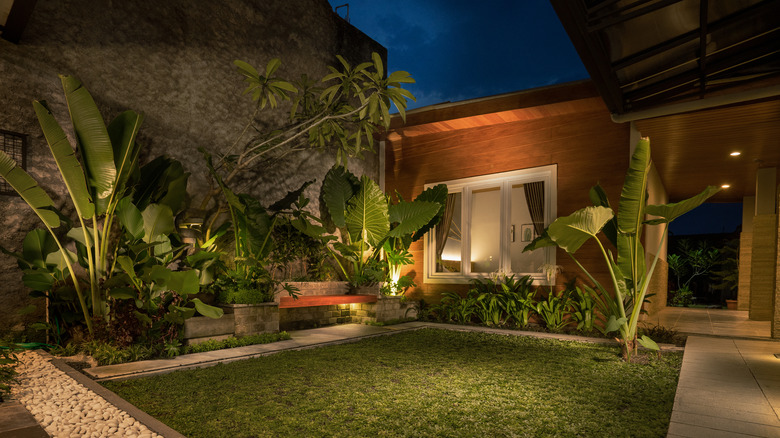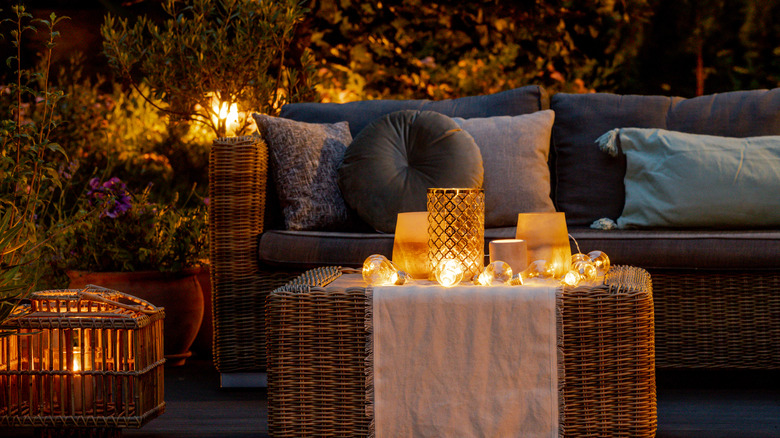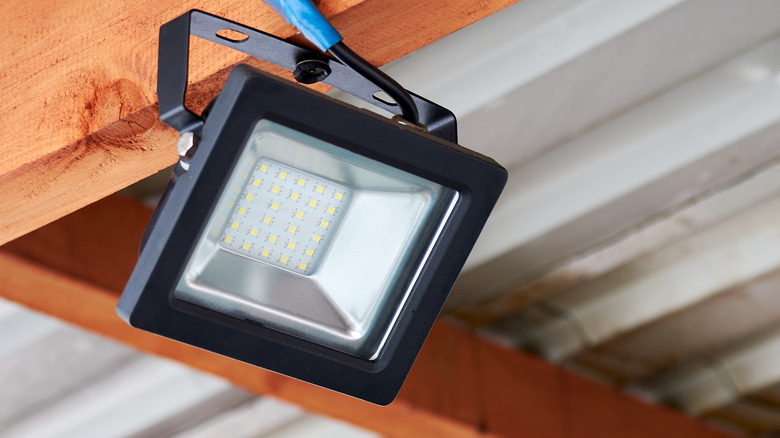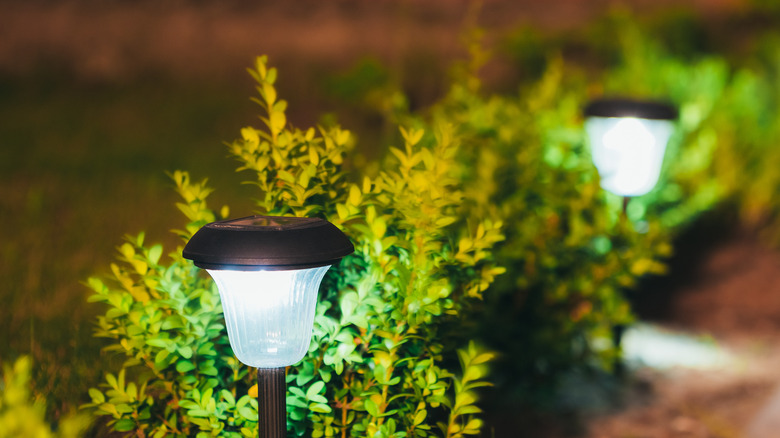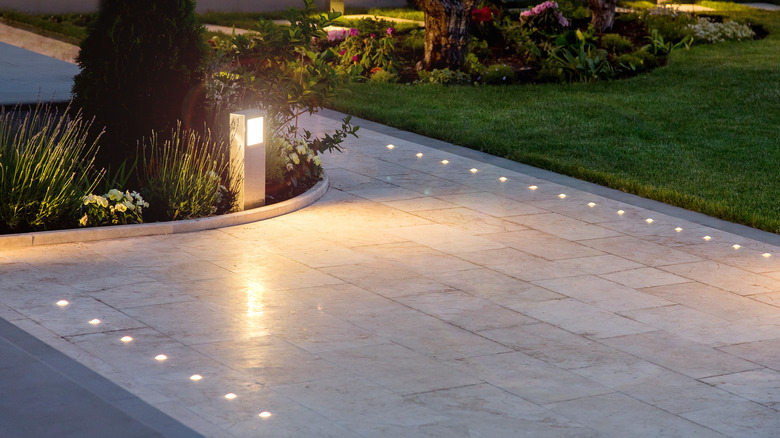How To Install Lighting In Your Garden
You've spent a lot of time investing in your garden and landscaping. Full of bright flowers, towering trees, and lush foliage, your garden is probably a source of pride. But at night, when it's completely dark, you might not be able to see any of your hard work. Landscape lighting can highlight the features of your yard and make it look like a professional designer created the space.
Outdoor lighting, however, isn't only to highlight the plants in your yard. It can also be effective for better illuminating your outdoor living space, porches, and railings or staircases, says Rasevic. Lighting also contributes to the mood, creating the perfect atmosphere for relaxing outside. Adding these features to your backyard can drastically change the space for the better, and there are many options that will allow you to customize the lighting in your garden and backyard space to your style and needs.
Consider the kind of light
Before installing any light fixtures, you should assess your space and determine the kind of lighting that would best fit. In gardens, spotlights, uplights, and downlights are all commonly used to highlight a particular feature, explains Premier Ponds and Lighting. Bollard lights that attach to wooden posts are also versatile options to illuminate a space, while string lights are often placed over the backyard to create ambiance.
It's important to think about your goals before purchasing any lighting fixtures. You may want to highlight a tree using uplight or bring attention to your flower beds with low-level lighting. You can use a mix of lighting styles in your backyard to give your space some depth. Taking inventory of the kind of lights you need will help create a more cohesive design plan.
You will also need to consider a power source. Outside, solar-powered lights are popular because they turn on and off by themselves. They can also be placed anywhere in the garden thanks to their lack of cords. Plug-in lights will need a power source or an outlet in order to work. You may want to consider how the power cords will affect both function and aesthetics.
Floodlights for ambient lighting
Floodlights are ideal for adding ambient lighting that illuminates the entire space. Floodlights can also provide security and safety for your home, especially if they are motion activated. High-powered, flood lights can even illuminate even the farthest corners of your property. These are usually installed on the side or back of the house and require a permanent power supply, which is why many homeowners opt to have an electrician do the work.
But that doesn't mean installing floodlights can't be done yourself if you have electrical experience. To DIY floodlight installation, start by selecting the right location. True Value suggests near entrances, garage doors, and places with lots of car or foot traffic. Then, find a power source and run wiring to the new light. You may need to drill a hole in the exterior of the home to feed the electrical cable through before connecting the fixture. After securing the wires, be sure the circuit is turned off before making the final connection. Attach the flood light to the side of the house and turn the power back on at the breaker box.
Pool lights and lights for water features
A water feature can be a stunning addition to a garden. A pond or a fountain can turn your backyard into a relaxing oasis, and you have a few options for ways to light them. Spotlights are an easy option to highlight a water feature with minimal installation. But if you want a built-in look, you'll need light fixtures that are especially waterproof. For lights inside ponds or pools, you may want to consider hiring a professional, as it's well known that lighting and electricity don't mix well.
Pool and pond lighting will require a waterproof power source like a GFCI outlet, says Baden Pools and Landscaping. A GFCI outlet regulates the electrical current through a circuit. If there is a problem, the GFCI outlet will immediately cut off the electricity. According to Pro Tool Reviews, these outlets can prevent fatal electrical shocks, which is important when it comes to lights in a pool — when it comes to electricity and water, it's best left to a licensed professional who can ensure safety.
Solar lights
Since they don't require wiring into a power source, solar lights are versatile and can be placed anywhere in your backyard. These lights simply need to be placed in an area where they can receive full sunlight during the day. While you may still be able to use these lights in shady backyards, they won't illuminate as brightly at night. Therefore, avoid locations where trees, vegetation, or fences that will shade the panels for most of the day, says Tom's Guide.
There are many styles of solar lights, from lanterns to string lights, so you can add them throughout your backyard. Some solar lights have the panels directly on the fixture, while others might be connected by a cord with a single solar charging panel. Meaning, that if you put the solar panel in a sunny spot, the lights themselves can sit in the shade. Installing the light fixtures can be as easy as sticking a stake into the ground or digging a hole to act as a foundation for a larger fixture.
Path lighting
Combining both beauty and function, path lighting illuminates walkways and hardscaping to make it easier to get through or to your backyard at night. Path lighting can increase the safety in your outdoor space by illuminating steps and paving stones and alerting you to potential hazards. According to Volt Lighting, there are two ways to approach path lighting: continuous illumination and pools of light. With continuous illumination, the lights from each fixture overlap each other, which requires the lights to be placed closer together. Pools of light have the light fixtures further apart, making the light more spotted throughout the backyard.
For most path lighting, you will need to wire the fixtures and connect them to your home's power, often using a low voltage transformer. There are also three types of mounting: stake mounting, where a stake is mounted to the fixture and placed into the ground; surface mounting, where the fixture is attached to a hard surface; and in-ground mounting, where you must dig and mount the fixture in the ground.
